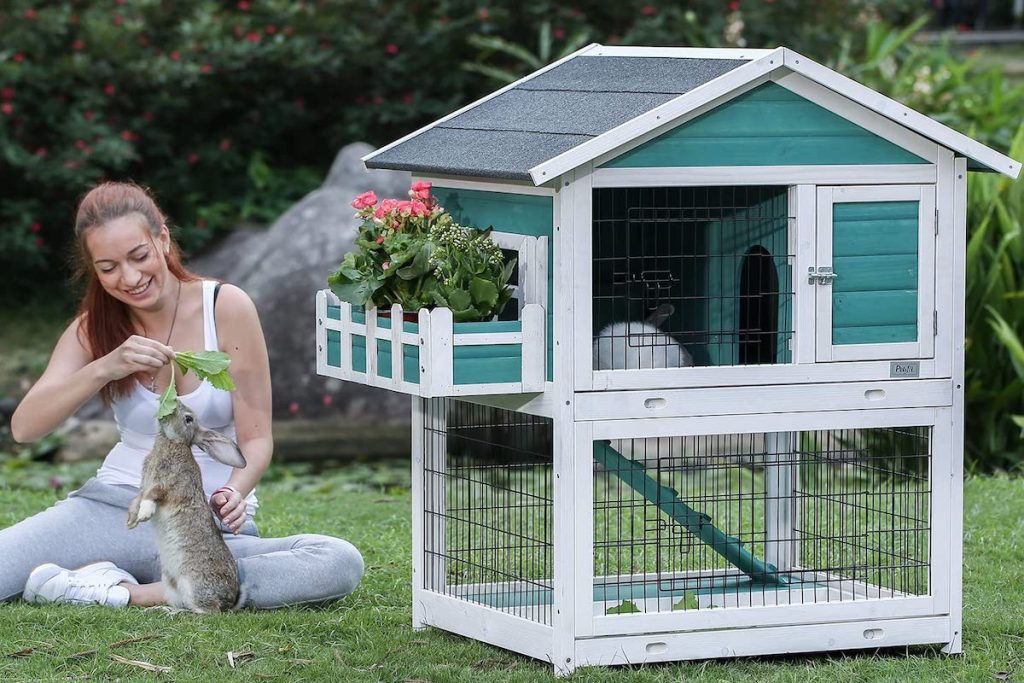Our rabbits can serve as endless sources of entertainment with their cute floppy ears, wiggling noses, and bushy tails. On top of that, they have big personalities and need space to roam as well. Some pet rabbits spend their days outside, enjoying the warm sun, but many need to live indoors if the climate or location requires it. That’s okay. Your bunny will thrive in your house as long as he has his own. When choosing a rabbit home, consider one of these outstanding indoor rabbit cages.
Good: MidWest Wabbitat Rabbit Home
Try out the MidWest Wabbitat Rabbit Home for a newly adopted pet. Make sure to go for the larger size if you house more than one creature or you have an extra-big bunny. This hutch folds completely flat, making it ideal for storage or travel. Between the removable plastic pan and the urine guard, you won’t have trouble keeping your rabbit and his enclosure clean. He’ll thank you for making sure his feet stay out of the bathroom area.
If you decide to house more than one animal, it should probably only be a mated pair or a mama with her babies since there’s no door to separate the cage into sections. Reviewers like this product especially for its ease of use and its durability.
Why we like it:
- Good for rabbits or other small pets like guinea pigs
- Doesn’t require any tools for quick setup
- Two doors for easy handling
- Removable parts encourage customization
Better: Aivituvin Rabbit Hutch
This cute combo house and cage makes for an excellent home for a bunny or two. Aivituvin Rabbit Hutch comes with a removable tray and an easy-to-open roof that makes for simple cleaning. Additionally, it can move around the house or between an indoor and outdoor space on wheels, which lock into place once you’ve found the right spot. This bunny house also includes a feeder and toy for you to indulge him immediately.
The best part is that it contains multiple openings and closures, which can help you access your rabbits or secure them inside — keeping them in and predators out. As owners point out, it looks good inside the home, so you don’t need to stress about having an unattractive cage in your living room.
Why we like it:
- Cute attached house for extra room
- Lots of doors and windows for display and ease of access
- Spacious enough for two rabbits or guinea pigs
- Predrilled holes make for easy assembly

Best: Petsfit Rabbit Hutch, Two-Story Wood Bunny Cage
Your bunnies will live in style with the Two-Story Petsfit Rabbit Hutch, which looks more like a mini rabbit mansion than a cage. Because it has multiple floors, bunnies can move up and down on the wood ramp (specifically designed to prevent sliding). This house is perfect for keeping two rabbits together because of the extra space and your ability to separate the top from the bottom.
Customers rave that it’s surprisingly easy to assemble and super simple to clean because of the multiple pull-out trays. The roof works quite well outdoors, but there’s no reason this adorable hutch needs to stay inside along with your pets. With multiple doors and windows, you choose how to access and display your animal.
Why we like it:
- Highly attractive, with spots for flowers or decorations
- Sturdy materials and real wood with pet-safe paint
- Works well with rabbits, chickens, and hedgehogs (though some pets won’t go up the stairs)
- Many doors and windows to get in and out quickly
No matter what kind of rabbits (or other small pets) you have, they’ll love living it up in an extra-large indoor rabbit cage. Keep in mind that some rabbits won’t tolerate living with another pet, even if they were littermates. It’s important to get a cage that allows for separation if you aren’t sure your little beasts will get along or if they need some space from each other. Also, while all these cages can be taken outside, you need to watch out for predators, changes in temperature, and sunburns. Think of it as a reason to enjoy the outdoors with your bunny!
Editors' Recommendations
- This is how long you can expect your new pet rabbit to live
- Best hamster bedding: The safest options for your furry friend
- What you need to know about sugar gliders before you get an exotic pet
- Bunny care 101: If Easter inspires you to adopt a rabbit, read this first
- Why do guinea pigs chatter their teeth? It’s not a good thing




